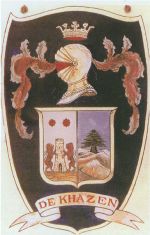
History
A Quick Note about the Khazen Family (An Introduction)
Written by Late Patriarch Boulos Massad, an Intellectual and Patriotic Man
Having we have seen that the Khazens were a main factor for Christians to be able to go back home in Keserwan, we decided to type this historical fact to keep it proven.
In summer 1922, we were able to trace in Saint Isaiah Abbey's library (Which belonged to the Anthony fathers) literature written by patriarch Boulos Massad, titled: "Short enlightenment on origins of the honorable family, El Khazen". This literature was part of a book named 'Al Dor Al Manthoum'. They were 10 pages from 301 - 310 and the manuscript was clearly and beautifully written. The man who was responsible for copying this brief note was Boulos Barhoush, a priest from Sahel Alman. He probably started copying this history before Massad was appointed a patriarch on 12 November 1854 and finished it on 22 March 1855, three months later as mentioned in last pages of the book.
"Al Dor Al Manthoum" was printed in Tamish Abbey in 1863 but this summary and other summaries written by the patriarch himself were not. We will add to this information, more information which we have discovered about Emir Fakhr Al Din and Cheikhs Abi Nader and Abi Nawfal, two brave heroic men who dominated this history indeed. This will fill the gap.
The crown Khazen family was born by the Maronite Chediak Sarkis El Khazen. This glorified personality lived in a village called Jaj in Mount Lebanon but following unknown circumstances and as time went on, he left his home in 1545 and moved with his family to another village called El Dar near to Keserwan but after some time, he moved again to another village called Ballouna in Ajaltoun, Keserwan. There he settled down with his children Abi Sakr Ibrahim and Abi Safi Rabah.
Chediak Sarkis and his sons enjoyed superior treatment and had special relationships with authorities, including the Ottoman governor, Emir Mansour Ebn Asaf, that is deriving from generous and kind socializing.
In 1584, Emir Korkomas governor of El Chouf had escaped Ibrahim Pasha, governor of Egypt hiding in a cave in El Chouf where he died but he had two sons, Emir Fakhr Al Din and Emir Younis. El Chouf the country was divided to two, Kaisi and Yamni and because mother of the two Emirs and Cheikh Kewan El Maroni were scared for their lives, they hid them with Chediak Sarkis El Khazen's sons. On the other hand, Cheikh Kewan El Maroni was responsible for managing Emir Korkomas's duties.
El Khazens were chosen for this urgent decision having them Kaisi, and because they were well known for their loyalty and trustworthy, their position and residence in El Chouf, and the fact that it was unlikely that they would be suspicious of because the Yamnies believed that El Khazens were their allies. Following this and following Chediak Sarkis El Khazen's sons approved such plea, they took care of the two young men and provided them good education and manners to grow up and become fine men. At that time, the Kaisies were going through rough conditions and they did not rebel against their oppressors because they did not have allies to support them. Keserwan then, was part of Ebn Asaf al Yamni's state. Above all, the Yamnies were fooled to believe that family of Emir Korkomas was demolished completely and that there was no successor after him.
But reality showed the opposite when the two Emirs showed on the surface. They were able to resist rulers, supported Kaisies' cause and in the end, Emir Fakhr Al Din ruled El Chouf. Emir Fakhr Al Din appointed El Khazen Cheikhs in his rule but Cheikh Abi Nader son of Ibrahim, son of Chediak Sarkis El Khazen enjoyed the highest position as he was appointed a manager of the Emir's business where virtually, they shared the rule.
In addition to the fact that Cheikh Abi Nader had a powerful position, he was intelligently carrying out his role, a reason that Emir Fakhr Al Din gained more power and glory so he governed many other areas in Mount Lebanon such Keserwan, Jbeil, Al Batroun, Bsharri, Tripoli, Al Markab. In 1612, Emir Fakhr Al Din had to travel to Tuscany to meet its governor so he appointed his brother Emir Younis Al Din to be his deputy while he was away. But Cheikh Abi Nader had the privilege to supervise and share this rule. In Emir Younis period, Cheikh Khater or Abi Rahal El Khazen was sent to Tuscany to hand Emir Fakhr Al Din letters informing him about the situation in the country. These letters said about the good work Cheikh Abi Nader had done and his genuine efforts. In a latter stage, Emir Younis appointed Cheikh Abi Nader a governor of Keserwan, a county which Emir Younis considered as belong to Cheikh Abi Nader; so Cheikh Abi Nader chose to settle down in Ghazir.
Emir Fakhr Al Din returns to El Chouf in 1617 after he spends five years in Tuscany. As Emir Fakhr Al Din was aware of Cheikh Abi Nader's genuine efforts while he was in his country or away, and their successful results to let Emir Fakhr Al Din exceed his power, Emir Fakhr Al Din confirmed what his brother, Emir Younis, wanted to grant. Keserwan the county was to be an asset of Cheikh Abi Nader and his family successors in tradition. Cheikh Abi Nader was to rule Keserwan that is starting from Nahr al Jamani to Al muamalatine and add to that, Cheikh Abi Nader governed Jbeil, Al Batroun, and Al Markab. It was believed that he built a castle called Al Musallaha; an armed castle to protect against intruders trespassers and enemies.
Terms in this Context:
Cheikh: A Christian Lebanese Duke
Emir: A Muslim ruler or governor